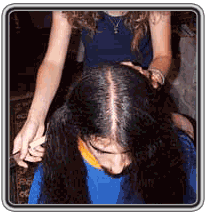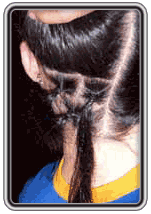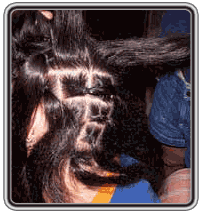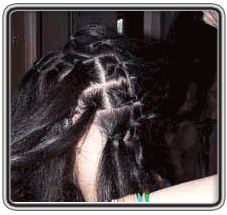Sectioning
Size, Shape & Placement of your Dreadlocks
Sectioning gives you a lot of options. By sectioning you can determine the size, shape and placement of each dread. Sectioning might seem like a lot of work. It does take a lil' while but we highly recommend it. If you don't section it, there is a tendency to end up with some dreadlocks a lot bigger than others and awkward spacing. Many people are overly concerned with having visible section lines. Section lines don't remain visible in mature dreads like you might expect. Some people offset each row, much like bricks are offset in a wall. This makes sectioning a touch trickier but it's an option that some people really like. After your dreads begin maturing it won't make a big difference either way.


You can either have a part down the middle or a row of dreads which will fall to one side or the other. It seems like everybody prefers the row of dreads down the center, including me, so I'm going to push you in that direction.
It doesn't really matter much unless you have a widows peak, in which case you'll definitely want a row down the center...
The other concern is your natural part. If you have a strong natural part try to keep your section lines on the part. This will keep your part happy, and believe you me, you want a happy part.
The center of their head becomes center of the first section. So if your sections are going to be one 1"x1" you'll want to create two parallel lines, one inch apart, that extend from the front of your hairline to the back of your hair (from your bangs to your mullet).
This will be your first row of sections, it should be centered on your head.
It will probably be helpful to clip the extra hair that falls outside the section out of the way and you'll be left with a row of unclipped hair down the center.
When you first start sectioning this will be a little messy because you'll have so much loose hair.
Next you'll start at the front and begin dividing the hair between the part lines into squares. The distance between them will equal your section size. As you create each section use a rubber band to hold it together. Put the band about 1/2" from the scalp. It just needs to be tight enough that it will stay put until you're ready to backcomb, at which point you'll remove it.
After the first row is divided into sections make another line all the way back that is parallel to the first two. Divide the hair between the lines as you did before.
As you work down toward the sides and move across the hairline you're going to have to adjust the shape and size of the sections to fit at times. There are no unbreakable rules here but you want to keep the amount of hair in each section about equal if you can and if you have to create rectangular sections make sure that they're horizontal rather than vertical.
When all the sections are in, check over them and try to pick out any that have a lot less hair or a lot more hair than the others. Solving this now will take a few minutes, solving it later after the dreads are in will be much harder. You might be able to borrow some hair or add some hair to surrounding sections to even things out. If the section has way too little hair try to combine it with adjacent sections. It's much easier to do this now rather than later. If you went with smaller dreads you'll probably still end up combining a few later, and that's fine, but fix what you can now while it's quick and easy. =]
After all the hair is sectioned give your sectioneer a hand! That's tedious work! You might want to snap a picture just for fun. Depending on whether your hair is long or short you either look like a dumb ass with little pony tails all over your head or a dumb ass with long pony tails all over your head. =]
Take the unclipped 1/2 and section it into squares. Each square should have about the same amount of hair.
 Put a rubberband thingy on each section to hold it so it doesn't get caught in the dreadlocks your about to make. Don't worry about the sections and rows being visible in the finished dreads, as the dreads grow and thicken the sections won't be noticeable. Try to keep the size sections as uniform as possible. The amount of hair in the section, of course, determines the size of the dread.
Put a rubberband thingy on each section to hold it so it doesn't get caught in the dreadlocks your about to make. Don't worry about the sections and rows being visible in the finished dreads, as the dreads grow and thicken the sections won't be noticeable. Try to keep the size sections as uniform as possible. The amount of hair in the section, of course, determines the size of the dread.
Bundles of hair about the size of a #2 pencil are good for dreadlocks of average size (about 1/4 inch in diameter) . If your hair is very fine the size bundles may vary, your diameter of hair may be smaller than a pencil and create sections of hair that are too big. Sections that are too big leave unnecessary space between the dreads. We recommend keeping the sections between an .5" square at the smallest to 1.5"-2" square at the largest. That should make sense but just in case it doesn't I'll elaborate....
 The dreads will end up being thicker than the bundle of hair (so if the bundle is as big as your pinkie the dreads are going to be bigger around than your pinkie, probably about 1/2'' in diameter) and the dreads will come out smaller than the section. After you do a few you'll have a pretty good feel for this. You'll be making the first dread in the back of your hair so you can make sure the size of your sections is right. You can adjust the others by the first one. Use your good judgment and take your time and they will come out supa nice.
The dreads will end up being thicker than the bundle of hair (so if the bundle is as big as your pinkie the dreads are going to be bigger around than your pinkie, probably about 1/2'' in diameter) and the dreads will come out smaller than the section. After you do a few you'll have a pretty good feel for this. You'll be making the first dread in the back of your hair so you can make sure the size of your sections is right. You can adjust the others by the first one. Use your good judgment and take your time and they will come out supa nice.
Remember, they don't hafta be perfect but getting them around the same size will pay off later on. Different size dreads will lock up at different speeds. Bigger dreads have the advantage of locking up faster. Thinner dreads have the advantage of drying faster and being more easily accepted by conservative straight haired folk.

